

Australian Bureau of Statistics, Australian Government. Australian Dietary Guidelines. The Australian Dietary Guidelines recommend the number of ‘standard serves’ we should consume from the five core food groups each day, for a nutritious and balanced diet.

The recommended intakes are an average to aim for each day. While it is normal to eat more of some foods on some days, and less on other days, what matters most is that you eat as close to these amounts as possible. This will ensure you’re getting an adequate amount of energy and nutrients in your overall diet. Separate Infant Feeding Guidelines exist (for healthcare workers) for children under 2 years of age, or click you can to download a brochure 'Giving your baby the best start'. Visit www.eatforhealth.gov.au for further information on the Australian Dietary Guidelines and recommended intakes.
Recommended daily intakes Recommended average number of standard serves per day * Additional serves are allowed for taller or more active people. Healthy fats Click here for more information on healthy eating for you. Australian Institute of Health and Welfare. Department of Health - Nutrients. There are 6 essential nutrients that the body needs to function properly.

Nutrients are compounds in foods essential to life and health, providing us with energy, the building blocks for repair and growth and substances necessary to regulate chemical processes. There are six major nutrients: Carbohydrates (CHO), Lipids (fats), Proteins, Vitamins, Minerals, Water. Looking at the AGHE, what food groups are the primary sources of each of the following ? Proteins: meat, dairy, legumes, nuts, seafood and eggsCarbohydrates: pasta, rice, cereals, breads, potatoes, milk, fruit, sugarLipids (most commonly called fats): oils, butter, margarine, nuts, seeds, avocados and olives, meat and seafoodVitamins: common vitamins include the water soluble B group vitamins and vitamin C and the fat soluble vitamins A, D, E and K. Digestive system explained. The mouth and oesophagus We need food to fuel our bodies for energy, growth and repair.
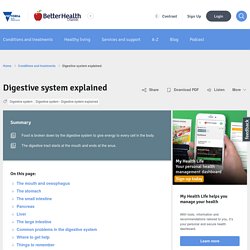
The digestive system converts the foods we eat into their simplest forms, like glucose (sugars), amino acids (that make up protein) or fatty acids (that make up fats). The broken-down food is then absorbed into the bloodstream from the small intestine and the nutrients are carried to each cell in the body. The digestive tract begins at the mouth and ends at the anus. It is like a long muscular tube, up to 10 metres long, with digestive organs attached along the way. Food Navigator. Metabolism. What Is Metabolism?
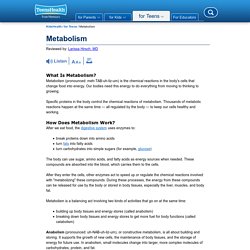
Metabolism (pronounced: meh-TAB-uh-liz-um) is the chemical reactions in the body's cells that change food into energy. Our bodies need this energy to do everything from moving to thinking to growing. Specific proteins in the body control the chemical reactions of metabolism. Thousands of metabolic reactions happen at the same time — all regulated by the body — to keep our cells healthy and working. How Does Metabolism Work? After we eat food, the digestive system uses enzymes to: break proteins down into amino acids turn fats into fatty acids turn carbohydrates into simple sugars (for example, glucose) The body can use sugar, amino acids, and fatty acids as energy sources when needed. After they enter the cells, other enzymes act to speed up or regulate the chemical reactions involved with "metabolizing" these compounds. Metabolism is a balancing act involving two kinds of activities that go on at the same time:
Video - Food Recipes that Increase Your Metabolism. Video - How your digestive system works. Agriculture in Australia: growing more than our farming future. AUSTRALIA 2025: How will science address the challenges of the future?

In collaboration with Australia’s chief scientist Ian Chubb, we’re asking how each science discipline will contribute to Australia now and in the future. Written by luminaries and accompanied by two expert commentaries to ensure a broader perspective, these articles run fortnightly and focus on each of the major scientific areas. In this final instalment, we examine our agricultural legacy. Food and agriculture are fundamental to human survival and it was the birth of agriculture and farming that laid down the basis for human civilisation.
Since the first crops were domesticated around 10,000 years ago, advances in agriculture have been intimately linked with human development and the growing world population. Technology and innovation have underpinned those advances. Australian Fisheries. Page Content Australia’s Commonwealth, state and territory governments manage fisheries in consultation with the fishing industry, scientists, economists and other user groups, such as those that represent traditional fishing, recreational fishing and environmental non-government organisations.

These management processes are used to implement controls, such as limits on catch or effort levels, and regulations of fishing methods in order to manage Australia’s fisheries in a sustainable way. In this section <div id="ctl00_ctl53_g_705cc760_1f62_4d13_b520_1c937b58be04_noscript">It looks like your browser does not have JavaScript enabled. Please turn on JavaScript and try again. Tips for searching our website This website has been designed to allow you to find the information you are looking for quickly and easily, just by using the search. To get the most out of the site, use as many key words as you can.
Australian Food Industry. Australian Food and Grocery Council. Ausralian Food Labelling. Page Content.
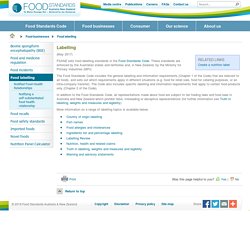
Australian Food Regulation. Australian Food Statistics - Department of Agriculture. CSIRO. Food Safety Laws. This video covers Food Safety laws in Australia.
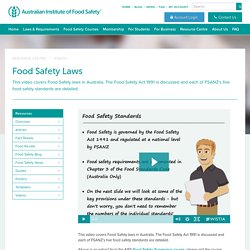
The Food Safety Act 1991 is discussed and each of FSANZ’s five food safety standards are detailed. Above is an extract from the AIFS Food Safety Supervisor course, please visit the course page for more information. Food Standards Australia and New Zealand. Food Industry Market Research Reports in Australia. NSW Department of Primary Industries. NSW Food Authority. HACCP Australia – Hazard Analysis Critical Control Points. Food Packaging Australia. Food Manufacturing Process. Food Preservation. The Gale Encyclopedia of Science COPYRIGHT 2008 The Gale Group, Inc.
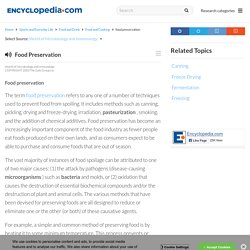
Food Processing. Breakthrough innovation comes slowly and cautiously to the food and beverage industry.
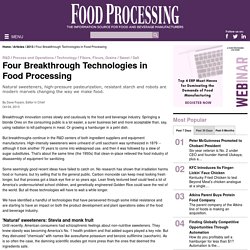
Springing a blonde Oreo on the consuming public is a lot easier, a surer business bet and more acceptable than, say, using radiation to kill pathogens in meat. Or growing a hamburger in a petri dish. But breakthroughs continue in the R&D centers of both ingredient suppliers and equipment manufacturers. High-intensity sweeteners were unheard of until saccharin was synthesized in 1879 -- although it took another 70 years to come into widespread use, and then it was followed by a slew of sugar substitutes. That's about the same time (the 1950s) that clean-in-place relieved the food industry of disassembly of equipment for sanitizing. Some seemingly good recent ideas have failed to catch on. Food Product Manufacturing Report in Australia. We use cookies to ensure that we give you the best experience on our website. By continuing to visit this site without changing your settings, you are accepting our use of cookies.
What is organic farming? Food Innovation Australia Ltd. Goodman Fielder - Great Brands and Great People. Poultry Operations - Baiada. Sanitarium Health Food Company Australia. Home - Sara Lee. McDonald's Australia. Australia's Favourite Brands. Taste Australia. Video - Food product development. Arthritis Australia. MedlinePlus. Australian Government Department of Health. Australian Health Advice. Australian Heart Foundation. Australian Indigenous HealthInfoNet. Cardiovascular Disease (CVD) - Types, Causes & Symptoms.
Other types of cardiovascular disease include heart valve disease and cardiomyopathy. How are cardiovascular diseases linked? Coronary heart disease (angina and heart attack) and stroke may be caused by the same problem – atherosclerosis. This is when your arteries become narrowed by a gradual build-up of fatty material (called atheroma) within their walls. In time, your arteries may become so narrow that they cannot deliver enough oxygen-rich blood to your heart. This can cause angina – a pain or discomfort in your chest. If a piece of the atheroma in your arteries breaks away it may cause a blood clot to form. When a blood clot blocks an artery that carries blood to your brain, it can cut off the blood supply to part of your brain. Find out more about how your heart works Atherosclerosis - your quick guide Atherosclerosis is the condition that causes most heart attacks and strokes.
Download What increases my risk of cardiovascular disease? Researching cardiovascular disease. Diabetes Australia. Dietitians Association of Australia – Leadership in Dietetics. Food Ethics Council. Food recalls. Malnutrition in Australia. Malnutrition is an under-recognised and underdiagnosed healthcare issue in Australia. It can result from poor oral intake, increased nutritional needs as a consequence of disease and or poor absorption, or excess nutrient losses associated with disease. Many contributing factors can increase the risk of developing malnutrition, including: age, mental state, presence of disease, poor food access, reduced mobility or difficulty swallowing, as well as side effects of treatment. Malnutrition results in negative health outcomes. It impairs the body’s immune response, making it more susceptible to infection and more difficult to treat infection.
Malnutrition also increases the risk of developing pressure injuries and delays wound healing. NSW Health. Nutritionally Modified Foods. Osteoporosis Australia. Type 2 Diabetes. World Heath Organisation - Diet and Nutrition.